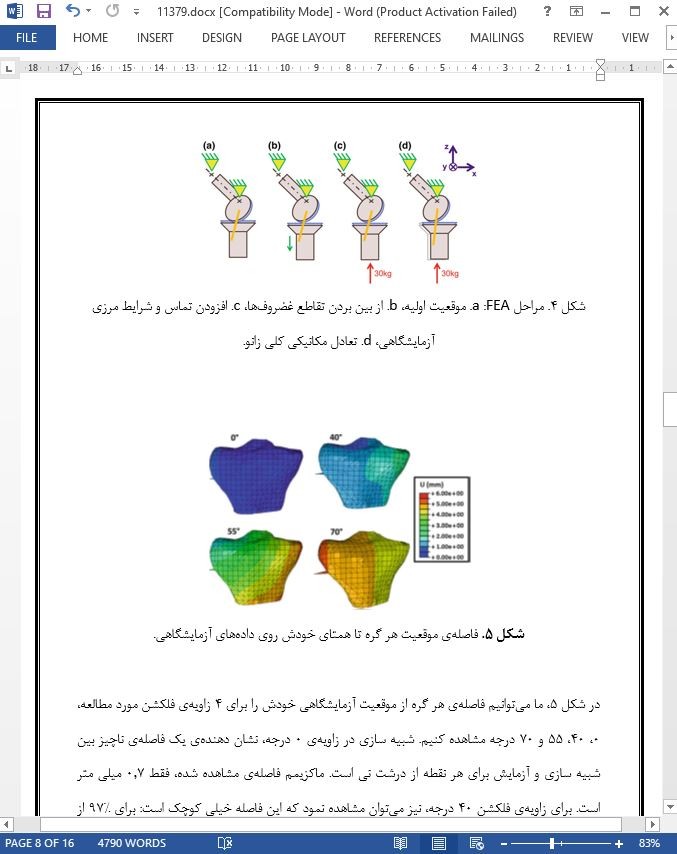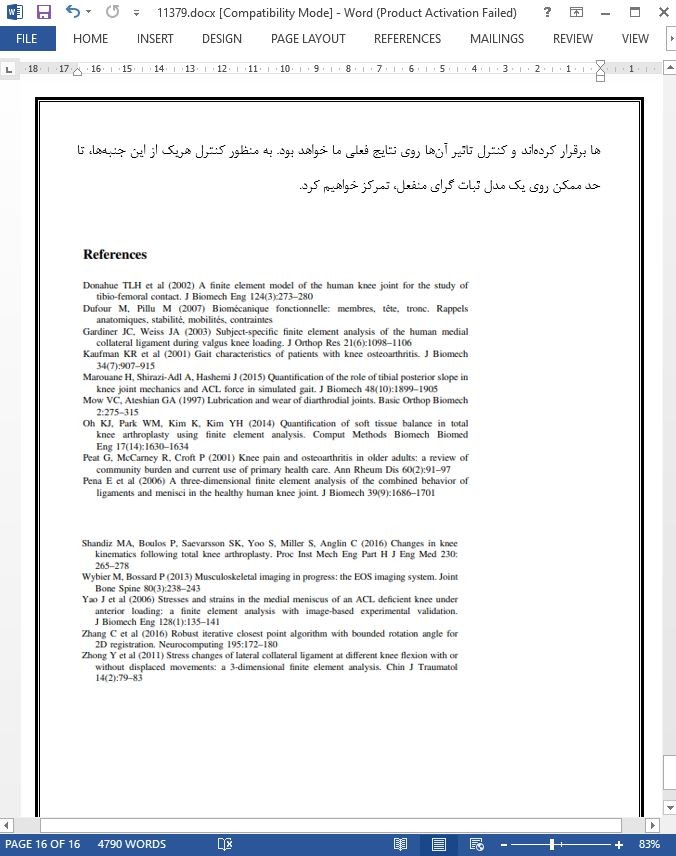
بارهای ناشی از بافت نرم روی زانوی سالم در فلکشن های فیزیولوژیک مختلف
چکیده
در این مطالعه، حرکت بالا رفتن از پله، به 4 تصویر EOS تجزیه شده است. سپس یک مدل زانوی 3 بعدی وابسته به بیمار، از روی MRI ساخته شد و چندین شبیه سازی عددی مطابق با شرایط مرزی آزمایشگاهی (زاویه ی نیرو و فلکشن) انجام شدند تا تعادل مکانیکی کلی زانو تضمین شود. به محض دستیابی به تعادل مکانیکی، به منظور تایید این مدل بیمار ویژه، ساختار استخوان وی با تصاویر EOS مورد مقایسه قرار گرفت. این مدل، تخمینی از فشار در رباط ها برای هر زاویه ی فلکشن و همچنین نقشه ی فشار روی غضروف ها را برای ما ارائه کرده است.
مقدمه
آرتروز زانو یکی از علل مهم ناتوانی در افراد مسن است. مطابق با مطالعه ی انجام شده در بریتانیا و هلند روی جمعیت 55 ساله و بیشتر، 25%، درد مزمن و مداوم زانو را اعلام کرده بودند (پائت و همکارانش، 2001). آرتروز، اثر ترکیبی تخریب غضروف، ضخیم شدن استخوان زیرغضروف و تشکیل استخوان جدید روی لبه های غضروف ها است. اصلی ترین ابزار تشخیصی بالینی برای آرتروز، رادیوگرافی است که اثرات آن روی تصاویر رادیوگرافی مشخص می شود ازجمله: باریک شدن فضای مفصل به دلیل تخریب غضروف، تغییر شدت سیگنال به دلیل ضخیم شدن استخوان زیر غضروف و تشکیل استخوان که مستقیما مشاهده می شود.
جمع بندی
به منظور مطالعه ی موضوع تخریب زانو و درد، در زمان ابتلا به آرتروز، هم در رابطه با فشار روی غضروف ها و هم ثبات زانو، یک مدل مفصل زانو ایجاد شد. ما یک رویکرد ترکیبی که هم شامل استفاده از یک تصویربرداری پزشکی (MRI، سیستم رادیوگرافی EOS) و هم پلتفرم نیرو همراه با یک مدل FE است را پیشنهاد کردیم. هدف، دستیابی به نقشه های فشار روی غضروف های زانو و فشار تحمیل شده توسط رباط های آن در طی فعالیت روزانه بود.
Abstract
In this study, the movement of climbing a step is decomposed in 4 EOS images. A patient-dependent 3D model of the knee is then created from MRI, and several numerical simulations are carried out according to the experimental boundary conditions (force and flexion angle), so as to ensure the global knee mechanical equilibrium. To validate this patient-specific model, its bony structure is confronted with the EOS images once the mechanical equilibrium is reached. This model gave us an estimation of the stress in the ligaments for every flexion angle as well as a pressure map on the cartilages.
Introduction
Knee osteoarthritis is one of the major causes of disability in older adults. According to a study conducted in the United Kingdom and the Netherlands on a population of 55 y.o. and more, 25% declared having chronical and persistent knee pain (Peat et al. 2001). Osteoarthritis is the combined effect of degradation of the cartilage, thickening of the subchondral bone and new bone formation on the edges of the cartilages. The main clinical diagnosis tool for osteoarthritis is the radiography, with effects being apparent on X-ray images: joint space narrowing for the cartilage destruction, variation of the signal intensity for the thickening of the subchondral bone and the bone formation is directly seen.
Conclusion
In order to study on the question of knee degradation and pain when developing osteoarthritis, related to both the pressure on the cartilages and the knee stability, a knee joint model was created. We proposed a mixed approach, both using medical imaging (MRI, EOS X-ray system) and force platform in conjunction with a FE model. The goal was to obtain pressure maps on the cartilages of the knee and the stress sustained by its ligaments during a daily activity.
چکیده
مقدمه
روش
اکتساب (جمع آوری) تصاویر EOS
مدل هندسی سه بعدی
مدل سازی المان محدود
شبیه سازی عددی
نتایج
موقعیت درشت نی
نقشه فشار غضروف
فشار رباط
بحث
شرایط مرزی و خصوصیات مواد
تایید مدل FE توسط موقعیت استخوان
نواقص مدل
نقشه های فشار و فشار رباط
جمع بندی
Abstract
Introduction
Method
EOS Acquisition
3D Geometric Model
Finite Element Modelling
Numerical Simulations
Results
Tibia Position
Cartilages Pressure Map
Ligament Stress
Discussion
Boundary Conditions and Material Properties
FE Model Validation by Bone Position
Model Shortcomings
Pressure Maps and Ligament Stress
Conclusion
- اصل مقاله انگلیسی با فرمت ورد (word) با قابلیت ویرایش
- ترجمه فارسی مقاله با فرمت ورد (word) با قابلیت ویرایش، بدون آرم سایت ای ترجمه
- ترجمه فارسی مقاله با فرمت pdf، بدون آرم سایت ای ترجمه



